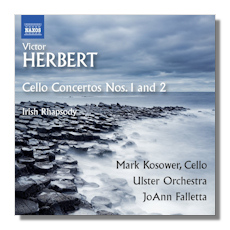
The Internet's Premier Classical Music Source
Related Links
- Herbert Reviews
- Latest Reviews
- More Reviews
-
By Composer
-
Collections
DVD & Blu-ray
Books
Concert Reviews
Articles/Interviews
Software
Audio
Search Amazon
Recommended Links
Site News
 CD Review
CD Review
Victor Herbert

- Cello Concerto #1 in D Major (1884)
- Cello Concerto #2 in E minor (1894)
- Irish Rhapsody for Grand Orchestra
Mark Kosower, cello
Ulster Orchestra/JoAnn Falletta
Naxos 8.573517 64:00
My only comparison with this recording is one by Lynn Harrell and Neville Marriner from nearly three decades ago, with the two concertos and 5 Pieces for Cello and Strings. (YoYo Ma has another recording I have not heard.) Prior to hearing the cello concertos my only acquaintance with Victor Herbert (1859-1924) was Babes in Toyland and other music of that sort. But his light music was a late development in his career, some time after he came to America. He was born in Dublin but grew up in Stuttgart, Germany, by way of a brief time in London in early childhood. He toured central Europe as a cellist and became a cellist in the Würtemberg Court Opera. He arrived in America in 1886. Herr Herbert never entirely lost a German accent. After joining a string quartet, and playing solo cello in several concertos, he began conducting and in 1889 he joined the teaching staff of the new National Conservatory of Music. Antonín Dvořák was the Director there and, when Herbert's Second Cello Concerto was premiered, Dvořák not only enthusiastically embraced Herbert but was inspired to write his own Cello Concerto.
Both of Herbert's concertos are in the traditional three-movement form, though in the second concerto, shorter than the first, the duration of the three movements were nearly the same, within two minutes. They are of course late romantic in mood. The first is more lyrical, the second more forceful, especially at the outset.
The pleasant Irish Rhapsody is largely based on traditional Irish songs and runs about a quarter hour.
I have no previous acquaintance with Kosower, but he studies with János Starker, of whom I have high regard, and he has appeared as soloist with orchestras on three continents under major conductors. His performance here is excellent, as is that of Falletta, who has an enormous repertoire.
Recommended.
Copyright © 2016, R. James Tobin


















